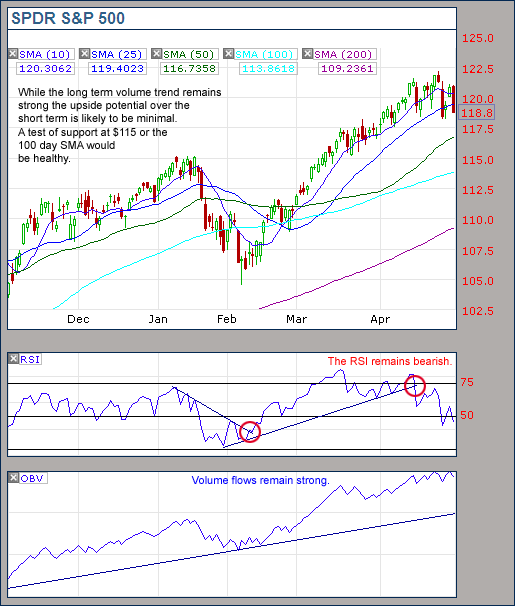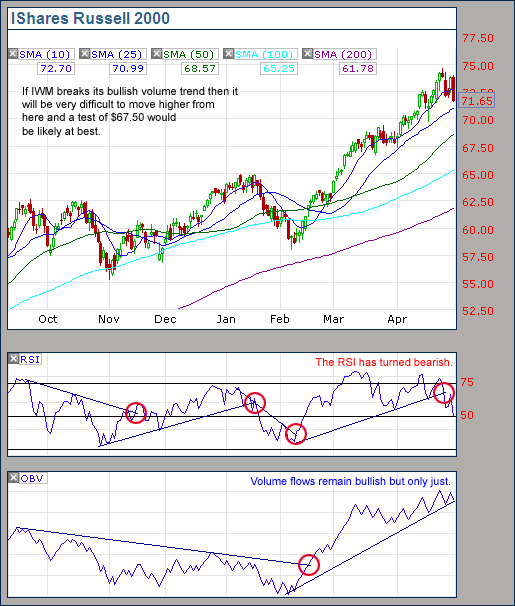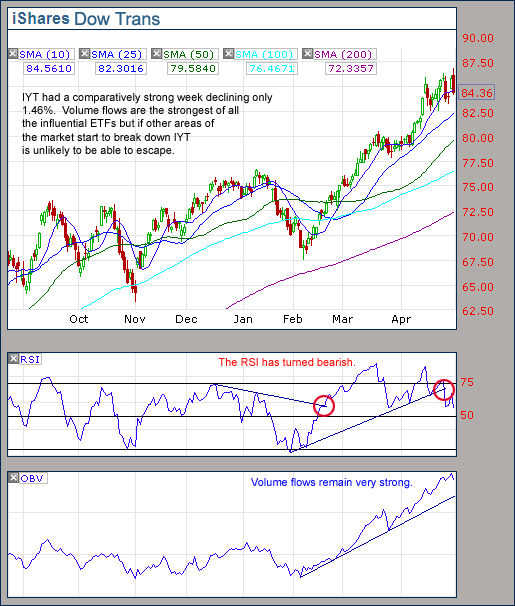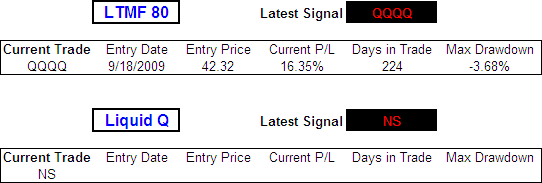May 03, 2010 – 02:10 am ET
Last week I warned that “the risk over the short term should not be ignored despite the recent exceptional performance” and the last few days have been a clear indication as to why. For several weeks now the risk/reward ratio has been slipping away from the bulls and is now not far from tipping into the bears favor.
.
ETF % Change Comparison
.

SMH was the big loser for the week which is concerning because of the influence it has over the NASDAQ, while IYT made a new high on just Thursday. From a longer term perspective is is good to see the Small caps (IWM) and the Transports (IYT) with the top performance ranks because they are both highly economically sensitive.
.
What the % Comparison Table Tells Us:
By comparing the performance of the economically sensitive (SMH, QQQQ, IWM, IYT) and the comparatively stable ETFs (SPY and DIA) we can get an indication of the true market direction. The more sensitive areas of the market tend to be the first to initiate a trend change. For example if DIA and SPY sell off heavily while SMH and IWM (Russell 2000 small cap ETF) sell of mildly or continue moving to new highs then this would be very positive and vice versa.
The ‘Average Rank %’ is calculated by subtracting the % change for each ETF from the maximum % change and dividing it by the range for each period. 1-((MAX(% change all ETFs)-ETFs % Change)/(MAX(% change all ETFs)-MIN(% change all ETFs))) The readings for each period are then averaged. This reading is provided because if one ETF was significantly under/out performing the others then a plain high or low rank would not accurately reflect this.
.
![]()
.
A Look at the Charts
.

Over the short term SPY is likely to encounter profit taking but it can suffer from some considerable weakness before breaking its long term bullish volume trend. QQQQ will give a better indication of the true direction of the market moving forward.
.

If QQQQ breaks its long term volume trend then it will be very difficult for the bull market to continue. The next two weeks will be crucial as an indication of the bulls strength.
.

I will be keeping a close eye on SMH’s volume trend for confirmation of direction moving forward but for now it remains bullish.
.

If we see profit taking from here then it is inevitable that IWM will break its bullish volume trend. If this break is confirmed by SMH also doing the same then you would be wise to become very defensive with your positions.
.

It is difficult to have a negative view of the market over the longer term when the transports are performing so well and on such healthy volume. Hopefully this is an indication that any profit taking will not evolve into a trend change.
.
![]()
.
OM3 Weekly Indicator
.

The OM3 indicator has issued its first ‘Bear Alert’ in 11 weeks which is not surprising after a week of declines on a overbought market.
.
How to read the OM3 indicator
The OM3 indicator as with most of our models primarily reads price action and volume. The strong/weak buy/sell signals are self-explanatory. ‘No Signal’ means that the component readings are in conflict and cancel each other out.
The alerts let you know if the cycle is speeding up or slowing down, so when you get at ‘Strong Buy, Bear Alert’ for instance it simply means that the criteria for a strong buy is in place but this weeks cycle reading is weaker (or more bearish) than last weeks reading (the same is true in reverse).
The number of weeks that a signal has been repeated is displayed. Historically a ‘Strong Buy’ signal has lasted for an average of 6 weeks and a maximum of 42 weeks, while a ‘Strong Sell’ has lasted for an average of 4 weeks and a maximum of 16.
This is an indicator not a mechanical trading model. It is useful to assist in analyzing the market but for the best results should be combined with commonsense and support/resistance levels etc.
.
![]()
.
TransDow & NasDow
.

No change here, the Transports remain dominant over the Dow and the Dow remains dominant over the NASDAQ.
.
What the TransDow Readings tell us:
The TransDow measures dominance between the DJ Transportation Index (DJTI) and the Dow Jones Industrial Average (DJIA). In a strong market the more economically sensitive Transportation Index should be dominant over the DJIA.
Historically the DJTI has been dominant over the Dow 45% of the time. The annualized rate of return from the DJTI during this period was 18.47% with the biggest loss for one trade sitting at -13.27%. The annualized return from the DJIA during the periods it was dominant over the DJTI was just 4.06% and the biggest loss for one trade was -16.13%. A 4% stop-loss is applied to all trades adjusting positions only at the end of the week.
What the NasDow Readings tell us:
The NasDow measures dominance between the NASDAQ and the DJIA. Using the same theory behind the Trans Dow; in a strong market the more economically sensitive NASDAQ should be dominant over the DJIA.
Historically the NASDAQ has been dominant over the DJIA 44% of the time. Taking only the trades when the NASDAQ is above its 40 week moving average the annualized rate of return was 25.47% with the biggest loss for one trade sitting at –8.59%. The annualized rate on the DJIA during the periods it was dominant over the NASDAQ is just 8.88% and the biggest loss for one trade was –12.28%. A 8% stop-loss is applied to all trades adjusting positions only at the end of the week.
.
![]()
.
LTMF 80 & Liquid Q
.

The LTMF 80 still has an active trade on QQQQ while Liquid Q remains in cash.
.
Historical Stats:
.

.
How The LTMF 80 Works
LTMF stands for Long Term Market Forecaster. It reads volume flows relative to price action and looks for out performance of volume measured on a percentage basis over the prior 12 months. During a sustained rally the readings will reach high levels (near 100%) making it imposable for the volume reading to always outperform price so any reading above 80% will maintain the buy signal. This system has outperformed the market over the last 10 years but performance has been damaged by some nasty losses. It only produces buy signals and only for QQQQ.
How Liquid Q Works
Liquid Q completely ignores price action and instead measures the relative flow of money between a selection of economically sensitive and comparatively stable ares of the market. It looks for times when the smart money is confident and and can be seen by through volume investing heavily is more risky areas due to an expectation of expansion. This system has outperformed the market over the last 10 years and remained in cash through most of the major declines. It only produces buy signals and only for QQQQ. We will provide more performance details on the web site for these systems soon.
.
![]()
.
Summary
.
If IWM, SMH and QQQQ break their bullish volume trends then we are likely to see some significant profit taking. In such case, depending on your investing time frame you would be wise to at least become very defensive with your positions. The declines so far have not been enough to warrant bearish positions on the broad market but they have been enough to encourage me to cash up all my bullish positions and take a few select bearish trades.
It is always a good idea to keep an eye on market action and have a defined plan of attack for each possible scenario but over the next few weeks I urge you to be particularly attentive.
.
Any disputes, questions, queries, comments or theories are most welcome in the comments section below.
.
Derry
And the Team @ ETF HQ
“Equipping you to win on Wall St so that you can reach your financial goals.”
.
P.S We have been doing a lot of research recently on the performance of common technical indicators across a 16 global global markets going back to 1989. Over the years I have found most of the popular indicators of little use and want to reveal which ones (if any) actually add value over a buy and hold approach. I will be publishing the results so let me know if there is something you would like us to test.
P.P.S Like ETFHQ on Facebook – HERE
.
![]()
.
The Devils Dictionary – L.
.
Leverage – The act of turning your problem into our problem. In theory, any gains from leverage are offset by a commensurate increase in risk. In practice, this theory is ignored.
Liquidity – A vogue term which provides an aura of financial sophistication to its user, as in, “an excess of liquidity drove the market higher, today” or “a lack of liquidity drove the market lower, today.”
Loser’s Game – The recognition that investors, in aggregate, are engaged in a zero-sum game – one person’s gains are equal to another’s losses, less the cost of transactions. Those who make fewest mistakes and have the lowest management expenses end up winning the loser’s game. The irrefutable consequence of this finding is that institutional funds should be largely invested in low-cost index funds. It is a tribute to the marketing power of the Wall Street that this isn’t the case.
Lucky Fool – A person who owes his success to luck rather than skill, but is unaware of the fact. As it takes several decades of performance data for statisticians to distinguish luck from skill in the investment game, the number of lucky fools on Wall Street must always remain indeterminate.
Derry,
As time consuming as this might be have you considered doing a posting of the positions bought and sold and % +/- on the trade? I like how you are looking at different factors than the norm in the market for direction. Keep up the good job on your research.
Thanks for your kind words Brian,
It is nice to know that people find some value in my ramblings. I certainly get a lot of value from putting my thoughts and actions out on public display. It is like the benefit one gets from keeping a good trading diary but magnified because you have to ensure that your reasoning stands up to the scrutiny of others and not just yourself. Plus the research that we are currently involved in is at its highest levels in years due to some strange motivation that comes from taking your ideas public that is more powerful than the promise of greater returns.
Anyway, to your question. I personally trade many different strategies and feel that it is important to display the results with the reason behind each position separately. My umbrella take on the market is shared in these newsletters along with the trades from several models. We must get round to sharing more details on the historical trades of those models trades, its on the to-do.
I will not share my experimental or discretionary trades on an on going basis because of the work involved in explaining what I am doing and the nature of some of them being experimental. From time to time I may share a specific discretionary trade setup however. Most of the discretionary trades I make are margined ETF or Call option trades and are usually only placed when Liquid Q is on a buy signal.
At this time the majority of my account follows a global ETF rotation model, the performance of which is independently verified by timertrac.com – http://bit.ly/bLTbAH – It is currently short EWJ (Japan ETF).
Soon we will get timertrac.com to follow an industry group rotation model that has almost finished its experimental trading period. The focus at the moment however is on pursuing some very promising new research, but there is also a book and tutorials on my trading philosophy to finish (and I am kinda lazy so all in good time).
Thanks for your question, hopefully that has answered it? Let me know if there is anything else you would like to know.
Cheers
Derry
P.S Are there anything particular technical indicators that you would like to see tested? We are running a massive testing process at the moment across a number of global markets.